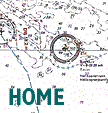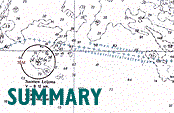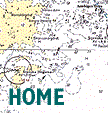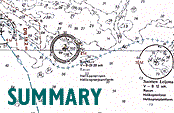 |
Liferafts
The liferafts (Figure 17.7) were launched partly by crew members and passengers and partly by automatically release and inflation when the vessel sank. The rafts were found very difficult to use in the severe sea conditions partly for the following reasons:
- Many rafts capsized due to the wind pressure and drifted upside down, and many did not fully inflate.
- Some of the upside-down drifting rafts were later righted by the waves (Figure 17.8). When this happened, however, those who were on the raft were again thrown into the sea and had great difficulties in climbing back.
- Capsized rafts with the canopy under water provided no shelter for those on board.
- The canopies of the rafts did not raise themselves automatically, and the openings could not be closed properly.
- Much water accumulated on the bottom of the rafts. In the worst case reported, there was 20 cm of water on the bottom of the raft. The bale scoops were so small that they were ineffective, and many survivors used their shoes to bale with.
- The knives on board the rafts proved to be useless.
- When the rafts were drifting the various lines for inflation and for keeping the raft in position for boarding constituted obstacles for people trying to board. The rope ladder went underneath the raft, swinging the feet of those who were trying to climb on, and thus affording practically no help (Figure 17.9).
- The operating head was not properly tightened to the CO2 pressure cylinder in many rafts found after the accident. This may be a reason why many rafts were not fully inflated.
- Entangled painter lines were also found around the operating heads.
Figure 17.7 ESTONIA’s Viking 25-K type liferaft.

Figure 17.8 ESTONIA liferaft drifting upside-down.

Figure 17.9 Ropes and the rope ladder in an ESTONIA liferaft as found after the accident.

As mentioned earlier the liferafts had no individual identification and were therefore not distinguishable. The helicopter crews and the mariners were unable to keep track of which rafts had already been searched. Many are believed to have been searched many times, thereby delaying the search of others.
 Another problem was that the black colour of the liferafts' bottoms made the rafts difficult to detect when floating upside down. Another problem was that the black colour of the liferafts' bottoms made the rafts difficult to detect when floating upside down.
 Examination of the recovered liferafts shows that almost all the drift anchors and their ropes were missing. Likewise, many emergency packs were missing. The missing equipment may have been lost during the rescue operation or later. Examination of the recovered liferafts shows that almost all the drift anchors and their ropes were missing. Likewise, many emergency packs were missing. The missing equipment may have been lost during the rescue operation or later.
 Liferafts were under these circumstances useful rescue equipment but the serious deficiencies listed above diminish their value in heavy seas and when people have to climb into them from the water. Liferafts were under these circumstances useful rescue equipment but the serious deficiencies listed above diminish their value in heavy seas and when people have to climb into them from the water.
17.7.2 Journalists in helicopters
On the morning of the accident, from 0812 to 1137 hrs, a Swedish Boeing Kawasaki helicopter carried two TV reporters. Between 1300 and 2025 hrs that afternoon, three Swedish Boeing Kawasaki helicopters each carried two reporters. A Finnish Super Puma helicopter flew journalists to Utö island from 1325 to 1530 hrs on the same day. On the next day, both Finnish and Swedish rescue helicopters flew journalists into the area.
 The Swedish Defence Forces justified flying in journalists by noting the importance of public relations and by referring to the positive feed-back received. The helicopter crews were told that they had the right to refuse to carry journalists. The commander who gave permission further justified this decision by noting that he, before the 0812 hrs flight, had been told by the pilots that no more survivors had been found at the scene of the accident. The Swedish Defence Forces justified flying in journalists by noting the importance of public relations and by referring to the positive feed-back received. The helicopter crews were told that they had the right to refuse to carry journalists. The commander who gave permission further justified this decision by noting that he, before the 0812 hrs flight, had been told by the pilots that no more survivors had been found at the scene of the accident.
 Representatives of the Finnish Frontier Guard noted that the journalists were flown in more than four hours after the last survivors had been found, and after a decision to reduce the numbers of helicopters in the area. The Finnish helicopter crew protested against their assignment, and flew the journalists around as quickly as possible to be able to return to search duties. Representatives of the Finnish Frontier Guard noted that the journalists were flown in more than four hours after the last survivors had been found, and after a decision to reduce the numbers of helicopters in the area. The Finnish helicopter crew protested against their assignment, and flew the journalists around as quickly as possible to be able to return to search duties.
 Carrying passengers on board helicopters engaged in rescue duties is not allowed without approval by the rescue leader, and is inappropriate in particular during such a large and difficult operation. In critical situations the carrying of passengers reduces transport capacity. Furthermore, it is questionable whether the privacy of the survivors should have been jeopardised immediately after their rescue by exposing them to cameras and journalists. Carrying passengers on board helicopters engaged in rescue duties is not allowed without approval by the rescue leader, and is inappropriate in particular during such a large and difficult operation. In critical situations the carrying of passengers reduces transport capacity. Furthermore, it is questionable whether the privacy of the survivors should have been jeopardised immediately after their rescue by exposing them to cameras and journalists. |
 |










